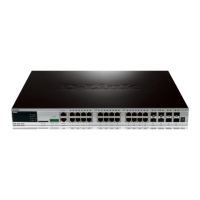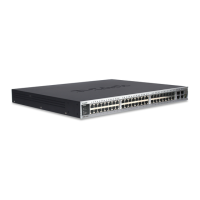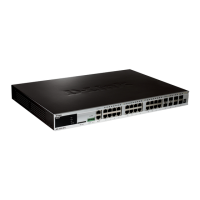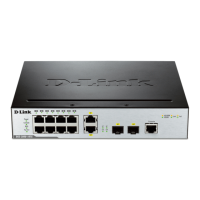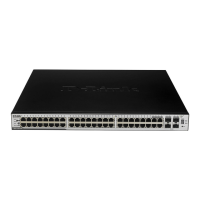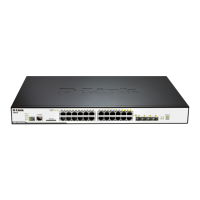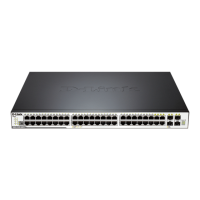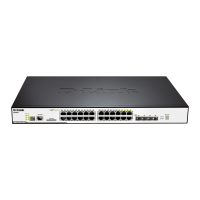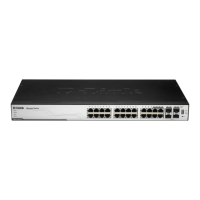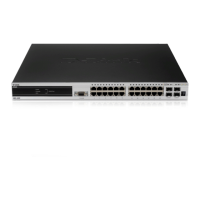
Do you have a question about the D-Link DGS-3427 and is the answer not in the manual?
Provides an overview of the D-Link xStack DGS-3400 series switches, highlighting their capabilities.
Lists the significant features of the xStack DGS-3400 Series switches, covering hardware and software capabilities.
Details the various port options available on the DGS-3400 Series switches across different models.
Illustrates and describes the components visible on the front panel of the switches.
Explains the function and meaning of the various LED indicators on the switch front panels.
Describes the connectors and ports located on the rear panel of the switches.
Details the side panels of the switches, focusing on ventilation and heat dissipation.
Lists the items included in the switch package for setup and installation.
Provides essential guidelines for safely and properly installing the switch.
Explains the procedure for installing the switch on a desktop or shelf.
Guides the user through the process of mounting the switch in a standard 19-inch rack.
Details the steps for powering on the switch after installation.
Describes how to install Small Form-Factor Pluggable (SFP) ports for fiber-optic connectivity.
Explains the installation of optional uplink modules like XFP or CX4.
Illustrates the connection and setup of an external redundant power system.
Explains how to connect end devices like PCs and routers to the switch ports.
Guides on connecting the switch to other network devices like hubs or switches.
Details how to connect the switch to a network backbone or server farm.
Outlines the available methods for managing the switch: Web, SNMP, and CLI.
Explains how to establish a connection using the console port for management.
Guides on initial login and setup for managing the switch via console.
Details how to create user accounts and secure access to the switch management.
Covers configuration of SNMP versions, community strings, and MIBs for network monitoring.
Explains how to assign an IP address to the switch for network management.
Steps to access the switch's web-based management interface.
Describes the layout and sections of the main web manager screen.
Details the three distinct areas within the web-based user interface.
Lists the main folders and subdirectories available in the web interface.
Allows viewing and configuring general switch settings like name, location, and contact.
Covers manual IP configuration, BOOTP, and DHCP assignment for network management.
Details how to configure individual port settings like state, speed, duplex, and flow control.
Explains how to add, modify, or delete user accounts and manage their privileges.
Details the Safeguard Engine for protecting the switch from network attacks and CPU overload.
Covers the configuration of static ARP entries for IP to MAC address resolution.
Details SNMP version support, community strings, and MIBs for network management.
Describes IP-MAC binding features for enhancing network security and preventing spoofing.
Introduces the concept of Single IP Management for managing multiple switches as a single entity.
Explains Virtual Local Area Networks (VLANs), including 802.1p priority and 802.1Q tagging.
Details port trunking and link aggregation for creating high-bandwidth pipelines.
Covers IGMP snooping for optimizing multicast traffic delivery.
Explains Spanning Tree Protocols (STP, RSTP, MSTP) for preventing network loops and ensuring redundancy.
Describes how the switch handles packet forwarding and filtering, including unicast and multicast.
Covers storm control mechanisms to monitor and manage broadcast and multicast traffic.
Explains how to lock ports to specific MAC addresses to prevent unauthorized access.
Details the configuration of 802.1X authenticator settings for port-based network access control.
Covers authentication policies, parameters, and server groups for user access control.
Explains Secure Sockets Layer (SSL) for secure communication, including cipher suites and certificates.
Describes Secure Shell (SSH) for secure remote login and network services, including configuration and algorithms.
Explains how to save configuration changes to NV-RAM and different save options.
Guides on restarting the switch, with options to save or discard changes.
Describes how to log out of the web-based management agent.
Displays the status of physical components like power supplies and fans.
Monitors the CPU usage percentage and provides real-time graphics.
Shows the percentage of available bandwidth being used on each port.
Provides statistics on received, transmitted, and broadcast/multicast packets.
Displays port error statistics, including CRC, under-size, and jabber errors.
Allows viewing the switch's dynamic MAC address forwarding table.
Lists general standards, protocols, and topology information for the switch series.
Details the physical dimensions, weight, power consumption, and environmental operating conditions.
Outlines key performance metrics like packet buffer, forwarding rate, and MAC address learning.
Provides pin assignment details for standard RJ-45 ports and connectors.
Outlines the terms and conditions of the limited warranty for hardware and software.
Provides contact details for D-Link technical support across various regions worldwide.
